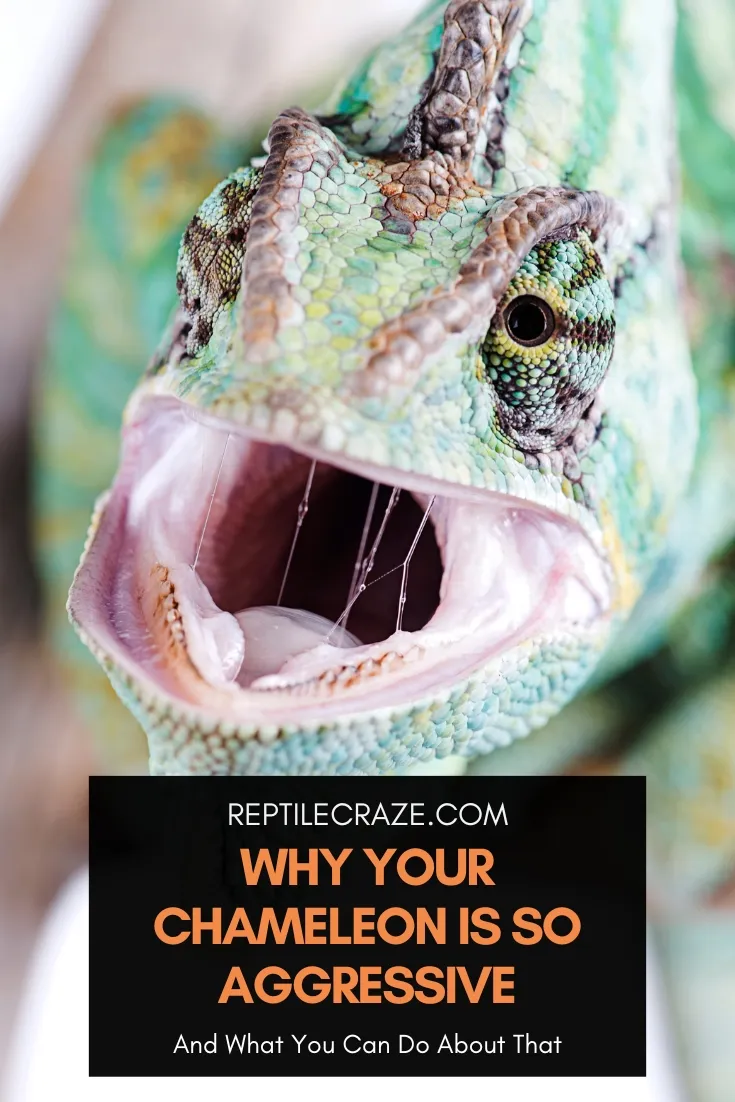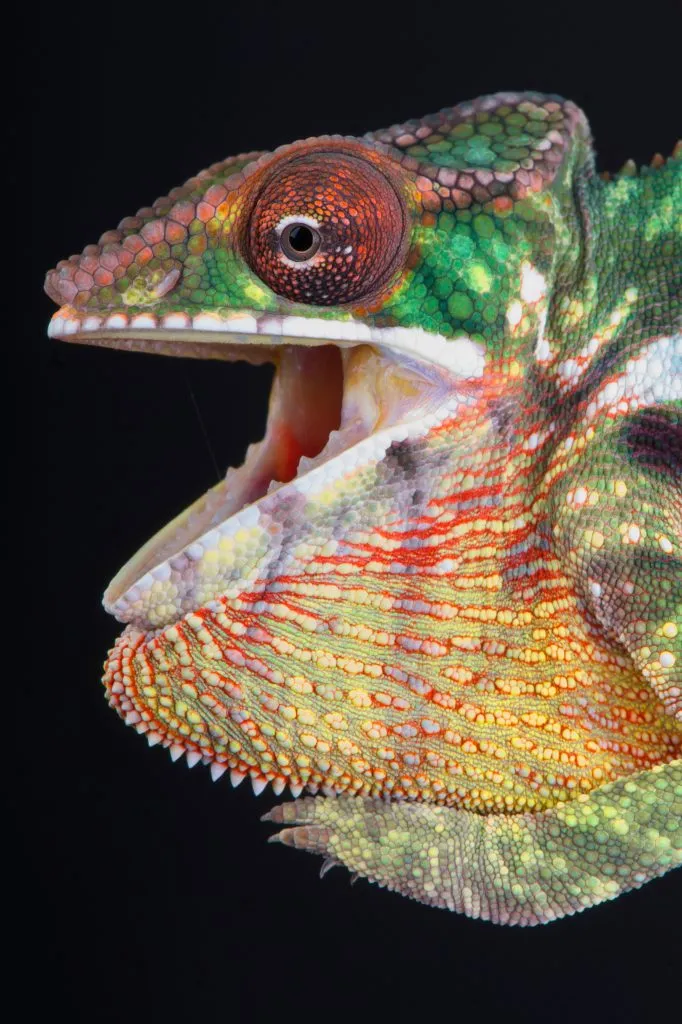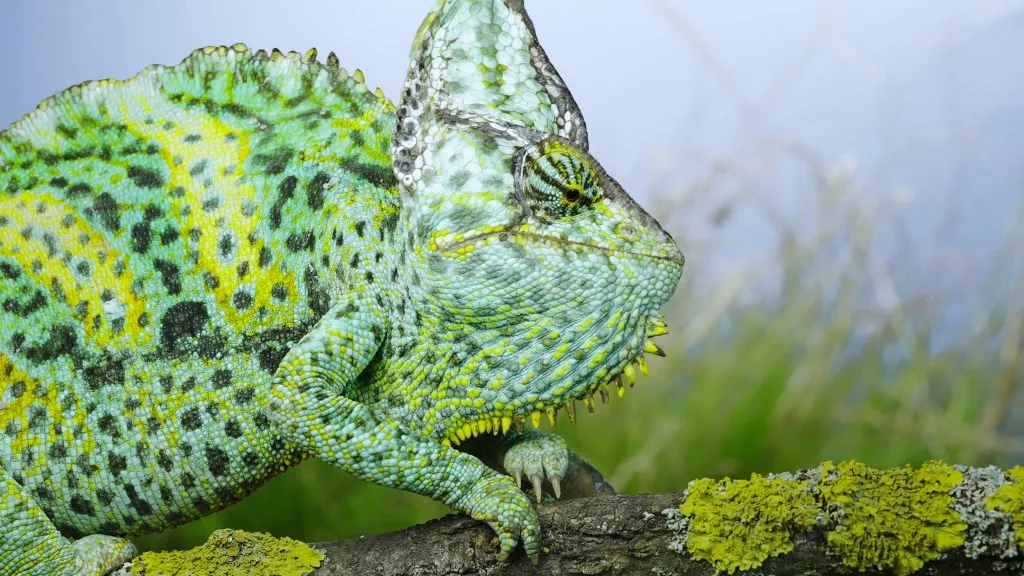
Chameleons may be fun to look at, but it is a different story when you try handling them and they repay you with hisses and bites. Why is your chameleon aggressive? Is there something you can do to minimize the aggression of your chameleon? How can you tell if your chameleon is aggressive?
The aggressiveness of chameleons is an exhibition of their defense mechanism. They can become aggressive when they are stressed, defending their territory, or when they have an illness or injury. Some signs of aggression are glaring eyes, darkening of the skin, gaping mouth, and puffing up.
In this article, you will learn why chameleons behave aggressively. We will also give you tips on how to calm down an aggressive chameleon. Read on to find out if your chameleon is considered more aggressive than others!
Table of Contents
Reasons Why Chameleons Are Aggressive
Chameleons do not behave aggressively just for the heck of it. They do so as something in their environment urges them to display this defensive mechanism.
There are a lot of studies regarding the defense mechanisms of chameleons, and most of them observed that their aggressiveness serves as a deterrent to potential predators.
They also resort to aggressiveness to buy some time to escape.
In general, chameleons are “flight reptiles.” They would rather camouflage themselves and escape to safety. Biting is their last resort.
If you are curious about how painful a chameleon bite can be, you can check out this article.
1. Chameleon Is Stressed
Chameleons prefer to be left alone as they are solitary reptiles. Therefore, if there is anything in their environment that disrupts their peace, they immediately perceive it as a threat.
In the wild, before a chameleon resorts to acting aggressively when it sees a potential predator, it has already escaped to a different area.
This cannot be done in captivity as they only have a definite space to move. This fact alone can make your chameleon more stressed.
It is also not good for a chameleon to be stressed for too long as it may get sick. At first, it will refuse to eat, then later on it will be lethargic.
Tip: Has your chameleon stopped eating? Read this article to find out why your chameleon is refusing to eat.
Here are the possible reasons why your chameleon is stressed.
Enclosure Issues
It is possible for a chameleon to get stressed when it feels that it is cramped in a small space. Aggressiveness usually happens if you have not changed into a bigger enclosure and your chameleon is already a juvenile.
Smaller enclosures mean that they have fewer climbing spaces and places to hide and explore.
They can also be stressed as they do not get much enrichment with the accessories inside the enclosure such as climbing branches, hanging vines, etc.
The activity and noise around the enclosure can stress your chameleon. If your other pets, like cats and dogs, go near the enclosure, or if your children are constantly checking out your chameleon.
Another stressor is when the enclosure is also near the window and your chameleon can see the activity outside.
Hand Feeding
It is also possible that your chameleon is stressed if you prematurely hand-feed them. If you have not established a bond of trust with your chameleon, it will get anxious when you try to hand-feed it.
Even if you are offering it
The same goes with some chameleons that are already used to their owners but at not entirely comfortable with hand feeding.
Housing Chameleons Together

It is never a good idea to house two or more chameleons in one enclosure. They do not thrive in communities and more often than not, they will resort to fighting and may even kill each other.
In the times that they just tolerate each other, they just retreat in separate spaces which also causes them stress as their areas are limited to the territories of one another.
The same applies if they can see other reptiles outside their enclosure, especially if the other reptile enclosure is beside them.
2. Chameleon Is Territorial
Besides being solitary reptiles, chameleons are also territorial. In the wild, when they claim a certain area as their territory, they resort to aggressive behavior to defend their territory.
This is more obviously seen in captivity as they view the whole enclosure as their territory.
Therefore, if your chameleon is still not used to your presence, it will become aggressive when you go near its enclosure. They may also hiss at you or lunge at you when you are trying to clean the enclosure.
3. Chameleon Has Illness Or Injury

Much like how humans get irritated easily when we are sick, chameleons express their discomfort by displaying aggressive behavior.
An injured chameleon feels vulnerable in its enclosure as it cannot move freely thus even small movements outside the enclosure will startle it.
Further, a chameleon suffering from an illness may be suffering from discomfort, lethargy, hunger, or even dehydration.
It feels exposed and unable to defend itself, so even though there are no threats around, it is naturally stressed. This is why it is difficult to administer medicine to chameleons.
Dying chameleons also display aggression more than their usual defensive behavior.
Tip: Are you worried that your chameleon might be dying? You can find out here if your chameleon is dying and what you should do now!
A Chameleon’s Aggressive Body Language
Here are the ways that chameleons display aggressive behavior.
Chameleon Is Lunging
When a chameleon lunges at you, it is their final warning before they unleash the wrath of their claws. Lunges are also the initial body language before they go for a bite.
When you see that your chameleon is already lunging when you are just around its enclosure, it means that they view you as a predator.
Chameleon Is Hissing
When a chameleon hisses, it can be a burst of air or a slow exhalation of air. They resort to hissing when they get startled or when they feel that you encroached on their territory.
It is a warning sign for them that means that they should not be bothered or handled. Never try handling a hissing chameleon.
The Chameleon Opens Its Mouth
You may think that your chameleon is yawning, but it is actually displaying its teeth. When your chameleon is staying still and just gaping with teeth showing, then it is ready for a bite.
This behavior is different when they are just gaping without showing their teeth. This one is associated with a respiratory issue.
The Chameleon Puffs Up
When chameleons puff up, they are trying to look larger than they really are to appear more intimidating.
This is characterized by having a longer appearance, the flap over their jaw, and they stand more erect almost unmoving.

Chameleon Is Turning Black Or Brighter In Color
Chameleons have the ability to change their colors based on what they are currently feeling.
If something is agitating or threatening them, they can turn darker or even black in color. The same goes if a green chameleon turns into a brighter green or red color.
Chameleon Is Glaring
It may come as a surprise that chameleons can actually glare at you. When this happens, your chameleon is intently watching you and assessing if you are a threat or not.
If you get closer and they are stressed, their eyes can also bulge out.
How To Calm Down An Aggressive Chameleon
Here are some tips to help minimize the aggressive behavior of your chameleon.
- Make sure that its enclosure is big enough based on its size and age.
- Provide a lot of climbing surfaces and hiding spots.
- Place the enclosure in a quiet and undisturbed area.
- When approaching the enclosure, do not make big and sudden movements.
- If you have other chameleons or reptiles that are beside the chameleon’s enclosure, put a cover in between the two enclosures.
- Take it slow when initiating contact. It should first be used to your presence before it can trust you for handling.
- Only attempt hand feeding if they do not display any aggressive behavior.
- In order to gain some trust, you can feed it using tongs or you can drop the
food on a nearby leaf. - Never egg on an already aggressive chameleon.
- When handling is permitted by your chameleon, place it in a comfortable area like a plant or a sunny spot.
- Do not force your chameleon to be taken out of its enclosure when it does not want to.
Are Some Chameleons More Aggressive Than Others?

In terms of gauging, whether a chameleon is more aggressive than the other, they differ in terms of how they express their defensive mechanism with regard to handling and stress.
There are chameleons that simply do not like to be held like the Veiled and Panther chameleon. While other chameleons like the Flap-Necked and Oustalet chameleons are more open to social interactions.
| Type Of Chameleon | Level Of Aggressiveness | Display Of Aggressiveness |
| Veiled Chameleon | Very high | They do not want to be held. They just want to be left alone. Can stay calm, but is aggressive in the presence of strangers. |
| Meller’s Chameleon | Medium | More likely to change color when it feels threatened. Biting is its last resort. |
| Panther Chameleon | High | Most of them do not want to be held. Some can become tame. |
| Four-Horned Chameleon | Medium | Gets easily startled by happenings around the enclosure. |
| Oustalet’s Chameleon | Low | Very open to handling once it trusts its owner. Does not get stressed too easily. |
| Carpet Chameleon | Medium | They are timid chameleons that can easily get stressed. More aggressive toward chameleons than to humans. |
| Senegal Chameleon | Low | Open to handling training but very territorial. Aggressive towards other chameleons. |
| Jackson’s Chameleon | Medium | Rarely goes for the bite but is territorial. Quite open to handling training. Only becomes aggressive when it feels threatened. |
| Fischer’s Chameleon | High | Does not like to be held but handling training is possible. The initial reaction to stress is to lunge and bite. |
| Flap-Necked Chameleon | Very low | Extremely calm and open to handling. Can turn into a darker color when aggravated. Easily gets stressed. |
| Pygmy Chameleon | Very low | Open to handling and not that territorial. Will usually puff up when stressed. |
It is good to note that whatever the aggressiveness level of the chameleon is, with a trusting bond and proper care, it is still possible to hold your chameleon.
You just have to be extremely patient and be in tune with the stressors of your chameleon.
Conclusion
By nature, chameleons are solitary reptiles that do not like to be bothered. Thus, they turn to aggressive behavior as a defense mechanism.
With the right enclosure conditions, stress management, and consistent handling training, your chameleon will learn to trust you and let itself be held.
- Enchi Ball Python: A Unique and Stunning Morph of Python regius - March 27, 2025
- Emerald Tree Monitor: The Enigmatic Green Guardian of the Rainforest - March 26, 2025
- The Egyptian Cobra (Naja haje): A Fascinating Serpent - March 25, 2025
